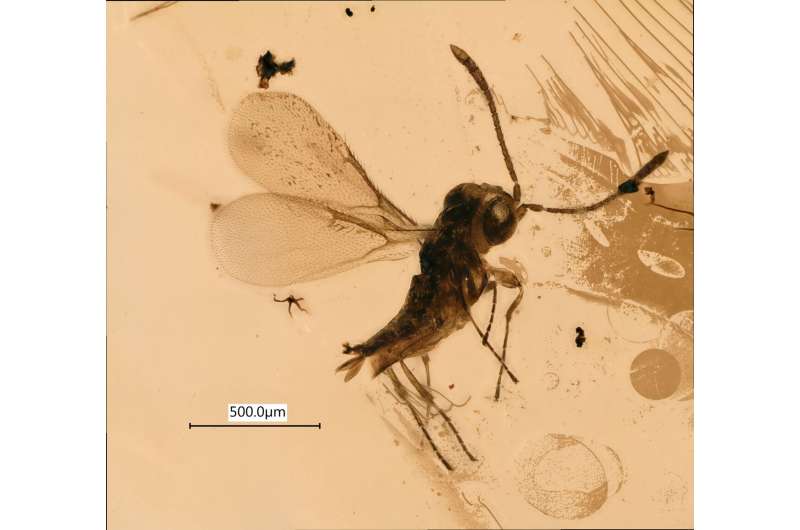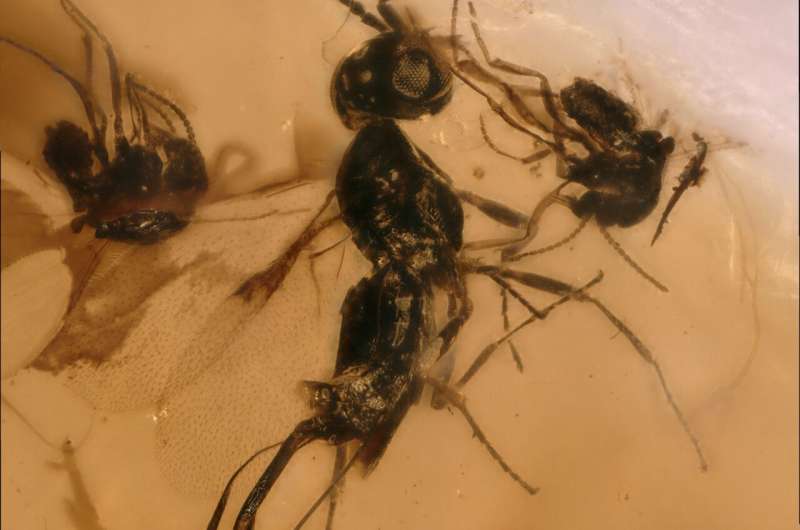This article has been reviewed according to Science X's editorial process and policies. Editors have highlighted the following attributes while ensuring the content's credibility:
fact-checked
peer-reviewed publication
trusted source
proofread
Oldest family of jewel wasps discovered in Cretaceous amber from Lebanon

Jewel wasps (Chalcidoidea) are one of the most diverse groups of insects, with more than 120,000 species described and an estimated true diversity of nearly 1 million. The chalcids are parasitoid wasps, which attack other insects to lay their eggs upon in order to feed and grow within the host.
The evolution and origin of this immense group has puzzled scientists for decades. Based on fossils and molecular work, the group is thought to have originated in the late Jurassic around 162 million years ago. Until recently, no confirmed fossils were known from earlier than 100 million years ago. Now, a newly described family, Protoidae, provides the first glimpse into how these wasps appeared at the earliest stages of their evolution.
Scientists Jonah M. Ulmer, Dr. Petr Janšta, and Prof. Dr. Lars Krogmann, from State Museum of Natural History Stuttgart (SMNS), alongside Dr. Dany Azar from the Lebanese University, describe the new family and 10 new species of jewel wasps in a paper in the Journal of Hymenoptera Research.
The discovery of the family came about when one of the co-authors, Prof. Dr. Lars Krogmann, noticed an unusual fossil during a visit to the Natural History Museum in Paris. The specimen embedded in the amber had a long tail-like structure covering its ovipositor.
"It was previously described as a completely different type of wasp; however the authors were quick to recognize it was indeed an ancient chalcid. Despite the prevalence of Chalcidoidea in the fossil record, none had ever been recorded from Lebanon or were known to be that old, nearly 130 million years old to be exact," says Jonah Ulmer.
The researchers soon realized they had a new and very old family; currently the oldest known within the jewel wasps.
"Multiple similar specimens in amber soon became apparent and the family now contains two genera, Protoita and Cretaxenomerus. The family name is derived from being a 'proto' form of the Chalcidoidea," Ulmer explains.

These ancient species present a unique snapshot of what these wasps looked like in their earliest forms, this allows researchers to better understand the order of evolutionary events through time and when certain structures evolved that ultimately led to the massive diversity we see today.
The new family's most striking characteristic is the long, shovel-like process, which extends from the end of the abdomen. While no living species have such a pronounced structure, it is hypothesized to have assisted with egg-laying and ovipositing, or perhaps sifting through loose leaf litter for hosts.
The authors note that there are likely other equally old families of Chalcidoidea still lying in wait to be discovered, either in the ground or in old forgotten museum cabinets. "Protoitidae shows that we can keep looking further back in time than we expected and still find new and old species," says Ulmer.
More information: Jonah M. UImer et al, At the dawn of megadiversity—Protoitidae, a new family of Chalcidoidea (Hymenoptera) from Lower Cretaceous Lebanese amber, Journal of Hymenoptera Research (2023). DOI: 10.3897/jhr.96.105494
Journal information: Journal of Hymenoptera Research
Provided by Pensoft Publishers





















